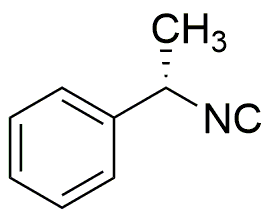(S)-(-)-a-Methylbenzyl isocyanide is widely utilized in research focused on
- Synthetic Chemistry: This compound serves as a versatile building block in organic synthesis, allowing chemists to create complex molecules efficiently.
- Pharmaceutical Development: It plays a crucial role in drug discovery, particularly in the development of novel pharmaceuticals, due to its ability to form stable interactions with biological targets.
- Material Science: The compound is used in the formulation of advanced materials, including polymers and coatings, enhancing their mechanical and chemical properties.
- Analytical Chemistry: It is employed as a reagent in various analytical techniques, aiding in the detection and quantification of other compounds in complex mixtures.
- Biochemistry: Researchers utilize it in the study of enzyme mechanisms and protein interactions, providing insights into biological processes at the molecular level.
General Information
Properties
Safety and Regulations
Applications
(S)-(-)-a-Methylbenzyl isocyanide is widely utilized in research focused on
- Synthetic Chemistry: This compound serves as a versatile building block in organic synthesis, allowing chemists to create complex molecules efficiently.
- Pharmaceutical Development: It plays a crucial role in drug discovery, particularly in the development of novel pharmaceuticals, due to its ability to form stable interactions with biological targets.
- Material Science: The compound is used in the formulation of advanced materials, including polymers and coatings, enhancing their mechanical and chemical properties.
- Analytical Chemistry: It is employed as a reagent in various analytical techniques, aiding in the detection and quantification of other compounds in complex mixtures.
- Biochemistry: Researchers utilize it in the study of enzyme mechanisms and protein interactions, providing insights into biological processes at the molecular level.
Documents
Safety Data Sheets (SDS)
The SDS provides comprehensive safety information on handling, storage, and disposal of the product.
Product Specification (PS)
The PS provides a comprehensive breakdown of the product’s properties, including chemical composition, physical state, purity, and storage requirements. It also details acceptable quality ranges and the product's intended applications.
Certificates of Analysis (COA)
Search for Certificates of Analysis (COA) by entering the products Lot Number. Lot and Batch Numbers can be found on a product’s label following the words ‘Lot’ or ‘Batch’.
*Catalog Number
*Lot Number
Certificates Of Origin (COO)
This COO confirms the country where the product was manufactured, and also details the materials and components used in it and whether it is derived from natural, synthetic, or other specific sources. This certificate may be required for customs, trade, and regulatory compliance.
*Catalog Number
*Lot Number
Safety Data Sheets (SDS)
The SDS provides comprehensive safety information on handling, storage, and disposal of the product.
DownloadProduct Specification (PS)
The PS provides a comprehensive breakdown of the product’s properties, including chemical composition, physical state, purity, and storage requirements. It also details acceptable quality ranges and the product's intended applications.
DownloadCertificates of Analysis (COA)
Search for Certificates of Analysis (COA) by entering the products Lot Number. Lot and Batch Numbers can be found on a product’s label following the words ‘Lot’ or ‘Batch’.
*Catalog Number
*Lot Number
Certificates Of Origin (COO)
This COO confirms the country where the product was manufactured, and also details the materials and components used in it and whether it is derived from natural, synthetic, or other specific sources. This certificate may be required for customs, trade, and regulatory compliance.


